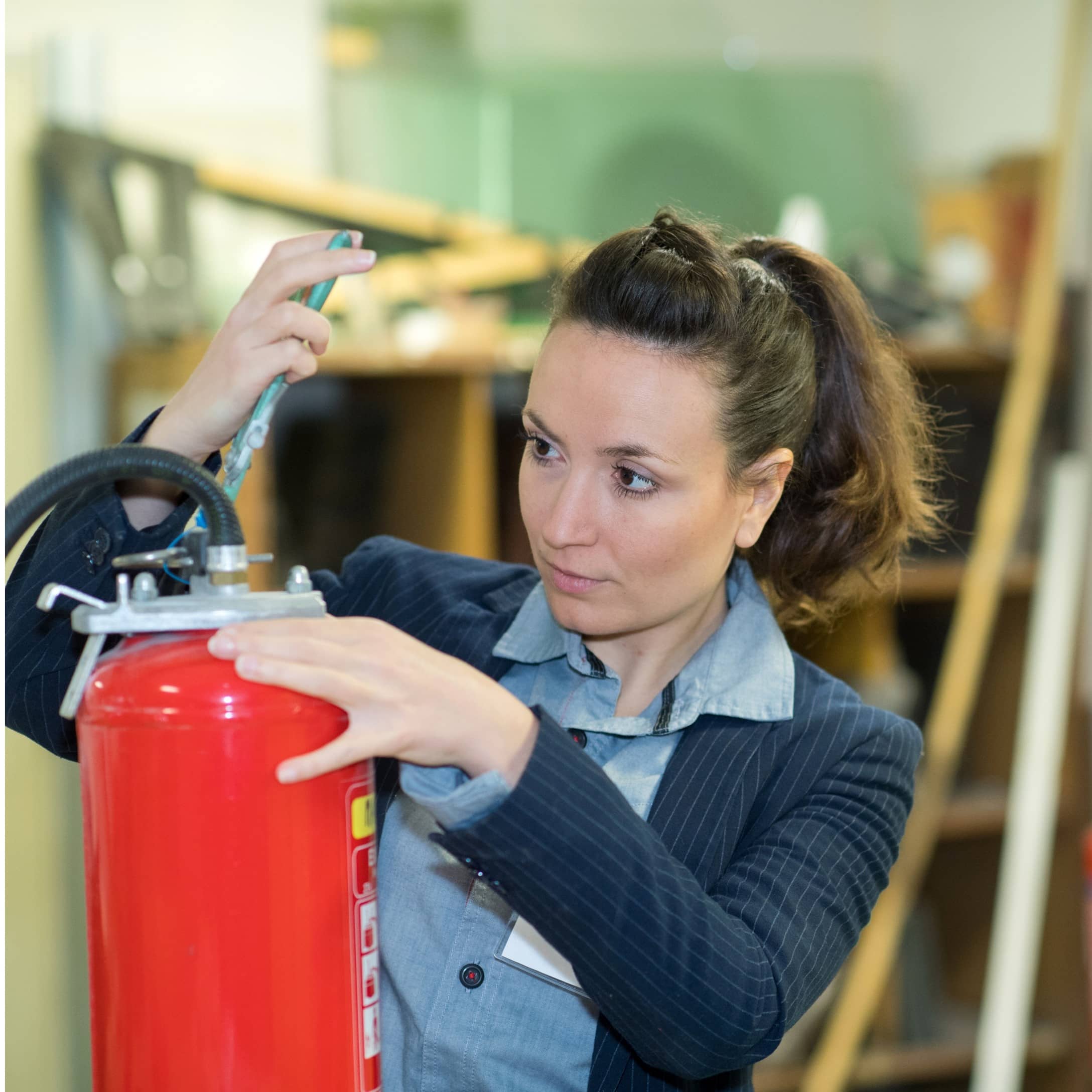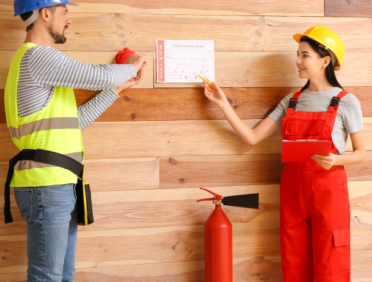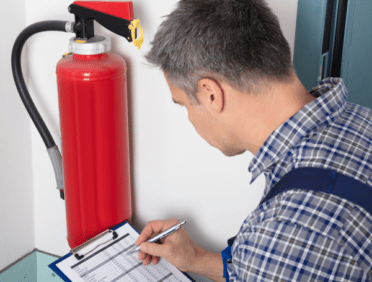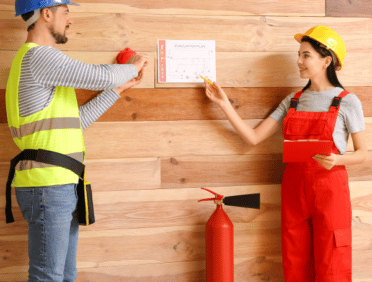The critical role of fire safety equipment in safeguarding lives and property
Whilst people being aware of fire safety is a great way to protect against fire in a property, it has to be said that the fire safety equipment that is on-site is also going to go a long way for safeguarding lives and property too.
To offer all-around protection, there are several different pieces of fire safety equipment that you can choose to install on your premises and allow people to use against fire when one is identified.
The importance of adhering to UK fire safety regulations
Another part of fire safety relates to adhering to the UK fire safety regulations. These regulations, are there to ensure that non-residential buildings are focusing on fire safety and are aware of how to keep staff and visitors as safe as possible whilst they are in work.
The regulations cover a wide variety of different aspects of fire safety. This includes:
- Essential fire safety equipment- which includes fire extinguishers and their codes/colours
- Maintenance checks on fire safety equipment to ensure that it is working well
- Maintenance of evacutor alarms
- Understanding the significance of fire safety equipment in ensuring workplace safety
If you do not adhere to these regulations, then you may find that your licence can be removed for your building, or use of certain parts of it. You may even, if the incident is serious enough, face imprisonment, which is a serious outcome.
Fire Protection and Its Significance
The best way to keep yourself safe from fire is to do your best to prevent and protect against it. Fire protection and prevention can come in a variety of forms and it will always be focused on taking a proactive approach rather than a reactive one (although reactive fire safety must also be a feature as this is what will be used to ensure that people are evacuated promptly).
Understanding the concept of fire protection and prevention
The idea of fire protection and prevention is that it is there to minimise potential fire hazards and help to protect people.
Fire prevention is there to ensure that the chance of fire breaking out is reduced and along with this, the chance of fire spreading through a building is lower.
Fire protection ensures that those people within the building are going to be able to get out of the building safely and with minimal threat to them.
Both of these are important and should not be ignored. Together they can create a complete approach to fire safety in your workplace.
UK fire safety laws and regulations
When it comes to fire safety in the UK for business premises the most important legislation to be aware of is The Regulatory Reform (Fire Safety) Order 2005. This was designed to include a variety of other regulations and laws that already existed but were complicated to understand and spread out over several health and safety regulations.
This particular Order relates to non-domestic properties. During 2022 the Fire Safety England Regulations were also created to help to further add to fire protection and safety in premises around the UK.
The responsibility of businesses to implement adequate fire protection measures
Business owners, managers and those who work in health and safety within the business are all responsible for the implementation of adequate fire protection measures, as are any employees that are assigned to be either a fire marshal or a fire warden within the business setting.
Together, these people must ensure that there are adequate fire protection measures in place that will keep everyone within the business safe. This includes risk assessments, fire safety policies and procedures and the maintenance of the equipment within the building too.
Decoding Fire Extinguisher Codes and Colours
One of the most common forms of fire safety equipment that you can have installed in your business premises is fire extinguisher. Most of us will recognise the usual standard type of fire extinguishers that we are used to seeing in our places of work, however, what we may not realise is that different types of fire extinguishers can be used for different types of fires.
Importance of selecting the right extinguisher based on fire hazards
It is vitally important that you use the right type of fire extinguisher based on the fire hazard that you are presented with. This is because each one is designed to extinguish that particular type of fire safely. They will contain different types of materials within them and these are what are going to put out the fire the best depending on what the root cause could be.
If you do not use the right type of fire extinguisher for the type of fire that you have, then you run the risk of not only not being able to put out the fire, but you may even making the entire fire worse and put more people at risk,
Fire Extinguisher Types and Their Applications
There are 5 different types of fire extinguishers that you can have in your workplace. You may only have one of them, you may have all of them, it depends on what type of premises you have, the work that you do and the types of risk that are most associated with you as a business.
The main types of fire extinguishers include:
- Water- which can be used on Class A fires that involve wood and paper. They have a red body and will be labelled with both the label “water” and also Class A. These fire extinguishers cannot be used on flammable liquids as they can cause the liquid to explode and they should not be used on fires that are electrical as the water inside can, when sprayed out, conduct electricity and make the situation even more dangerous.
- Powder- these come with a red finish and can be used on all types of fire. They are best when used on Class B fires. They extinguish the fire by using the chemical powder inside to stop the combustion. It is worth taking care of if you are using this type of fire extinguisher in a confined area.
- Carbon Dioxide CO2 Fire Extinguisher- these also have a red body, however, will come with a CO2 label. They are safe to use on electrical fires, however, they work best on fires that are within Class B.
- Foam- Foam extinguishers can be used on both Class A and Class B fires, however, it is important to know that they cannot be used on electrical fires as they can create a moist environment which can conduct electricity.
- Wet Chemical- these extinguishers are red like the rest, but they are also finished with a bright yellow label. They are specifically designed to be used on cooking oil or fat fires. They can, however, also be used on Class A fires safely. They are designed to smother the fire and cool it down. This is achieved by the fine nozzle which creates a mist spray. It is important not to use this type of extinguisher with electrical fires, however.
Download your FREE Fire Extinguisher Colour Codes Poster by clicking here
Fire Extinguisher Classification Codes
Each of the fire extinguishers has classification codes that can relate to the type of fires that they can put out.
It is important to recognise these classification codes because they not only increase your chance of putting out the fire, but they also will stop the issue of the fire being made worse, or putting the person in danger.
Class A:
Suitable for fires involving ordinary combustibles like wood, paper, textiles, and plastics.
Corresponding fire extinguisher code: A
Class B:
Designed for fires involving flammable liquids such as gasoline, oil, and paints.
Corresponding fire extinguisher code: B
Class C:
Intended for fires involving flammable gases like propane, butane, and methane.
Corresponding fire extinguisher code: C
Class D:
Used for fires involving combustible metals like magnesium, sodium, and potassium.
Corresponding fire extinguisher code: D
Class F:
Suitable for fires involving cooking oils and fats, commonly found in kitchens.
Corresponding fire extinguisher code: F
Class Electrical:
Specifically designed for fires involving electrical equipment and appliances
This is not a formal classification but is often considered part of the overall fire safety considerations.
Significance of fire extinguisher colours:
Red:
Water Extinguishers: Used for Class A fires involving ordinary combustibles like wood, paper, textiles, and plastics.
Cream:
Foam Extinguishers: Suitable for Class A and Class B fires involving flammable liquids like gasoline, oil, and paints.
Blue:
Powder Extinguishers: Effective for Class A, Class B, and Class C fires involving flammable gases like propane, butane, and methane, as well as flammable liquids.
Black:
CO2 (Carbon Dioxide) Extinguishers: Designed for electrical fires and flammable liquid fires
Yellow:
Wet Chemical extinguishers are primarily used for Class F fires involving cooking oils and fats in commercial kitchens.
Download your FREE Fire Extinguisher Colour Codes Poster by clicking here
Ensuring proper labelling and visibility of extinguishers in different settings
To ensure that you only ever use the right fire extinguisher for the related type of fire, it is important that your extinguishers are properly labelled and that the labels are always visible. This means that those who go to use the extinguisher will be able to ascertain which one they will be able to use.
Who is responsible for using a fire extinguisher?
The responsibility for using a fire extinguisher typically falls on individuals who are trained in its proper use, such as employees in workplaces, building occupants, or anyone who might encounter a fire situation.
Fire Extinguisher Checks and Maintenance
Just like any piece of equipment, fire extinguishers of all types need regular inspections and maintenance.
The importance of routine inspection and maintenance
Fire extinguishers, over time, can degrade and stop working as effectively as they may need to. This means that they need to be fixed or replaced. The only way to pick up on the fact that this needs to happen is with a routine inspection and then any subsequent maintenance that comes out of the inspection.
These inspections will help you to discover what you may need to do to make the fire extinguishers work for you and ensure that they are going to be able to put out the fire when they are used.
A Step-by-step guide to conducting fire extinguisher checks
- The first thing that you need to look at is how easy it is to get to the fire extinguisher. There is a good chance that whoever is going to need the fire extinguisher, will need it in a hurry, so it will need to be accessible. It should be easy to spot and then when it is spotted it should not have anything in front of it.
- The next thing that you need to do is to examine the physical state of the extinguisher, of course, this one won’t always pick up an issue but will give you a good indication that something is going on. You want to take a look at the serial number of the extinguisher, then take a look at the condition of it, are there any dents or spots of damage on there? Is the hose securely connected to the cylinder? There should be no cracks in the hose or a potential leak site in the nozzle. The locking pin should go through all of the holes in the discharge lever and handle and should be secured well.
- Once you have looked at the entire fire extinguisher, you should then take a look at the pressure gauge. The gauge needle should be in the green zone. If it is in the left red zone then this means that the extinguisher is undercharged and will need to be recharged. If it is in the right red zone then it is overcharged.
You must record when you checked the extinguisher. This could be on the inspection tag if there is one, or on the record that you keep.
Collaboration with certified professionals for servicing and testing
Whilst some of the checks can be carried out by you in the workplace, some things need to be dealt with by certified professionals. If the process requires a professional, then you need to make sure that you get them in and that you work with them to ensure that the things that need to be improved on, are improved on.
Evacuator Alarms: Enhancing Emergency Response
When a fire has been identified or is suspected everyone on the premises must find a way to get out of the building safely and quickly. This may require an evacuation alarm.
Evacuator alarms and their role in emergencies
Evacuator alarms ensure that everyone knows that there is an emergency and that they need to get out of the building. They work in a variety of ways, depending on the nature of the work that is carried out and the type of premises that they are in too.
Types of evacuator alarms
- Audible-Only Evacuator Alarms- this alarm will sound an audible warning that there is a need to evacuate the building. There is no other type of alarm or warning on the alarm.
- Visual Evacuator Alarms- these alarms will emit a light signal, that alerts those within the area that there is a possible fire and that they need to evacuate the building.
- Combined Audible and Visual Evacuator Alarms- these alarms combine both the visual and the audible parts of evacuator alarms and are amongst the most common to be seen in buildings
- Wireless Evacuator Alarms- these alarms work just like other forms of alarms, however, they do not need to be wired into the existing system, they can work through a radio-frequency instead
- Addressable Evacuator Alarms- an addressable evacuator alarm will highlight which alarm has been set off and where that alarm is, this can help you to pinpoint the location of the potential fire easier
- Integration with Fire Detection Systems- you can combine an evacuator alarm with other types of fire detection systems, including door locking and unlocking, fans and also sprinklers too
- Remote Triggering and Control- if you want to be able to control the evacuator alarm away from the building then you will want to install a remote-controlled and triggered alarm system
- Mobile Apps and Smart Integration- you can take the above type of alarm one step further and install one that works with smart speakers and mobile apps
Integration of evacuation alarms into comprehensive emergency evacuation plans
Evacuation alarms are designed to ensure that it is easier to evacuate people from the building. This means that if you install them on your premises, they can quickly become a key part of your emergency evacuation plan.
They will often be the first alert in the case of a fire, the alert that signals to those within the building that there is a fire and that they need to evacuate quickly.
Implementing Effective Fire Safety Protocols
Fire safety should be something that becomes an everyday part of your working day, something that everyone should recognise and be aware of, after all, a fire can happen at any point. Therefore it should always be something that is looked at.
Integrating fire safety equipment into workplace safety policies
It is advisable to ensure that any workplace safety policies that are created for your workplace include fire safety equipment. That way you will not overlook your fire safety equipment and ensure that it is checked over and maintained frequently.
Training employees on proper usage of fire extinguishers and evacuator alarms
Another key aspect of implementing effective fire safety protocols in your business is ensuring that your employees are properly trained on the use of fire extinguishers and evacuator alarms. You need to ensure that everyone, not just those who are responsible for fire safety is aware of how to use them so that in an emergency there are as many people as possible who can use them and try to stop the fire from spreading and becoming worse.
Conducting regular fire drills to practise emergency response procedures
The best way to make sure that everyone in your business understands what to do in a fire is to conduct regular fire drills. These are designed to be practice runs of what would happen in the event of a fire and should be treated as such.
They will ensure that everyone knows what to listen to or look out for when it comes to a fire being identified or suspected and where they need to be when they have left the building.
Regular fire drills will help everyone to feel more settled when it comes to what will happen during an evacuation and will make them less likely to panic. This will help the entire process to go much smoother in a real-life situation.
Future Trends and Technological Advancements
Things change over time and fire safety is no different. There are always new ways to ensure that people are kept safe within a business and that there are proper prevention measures taken against potential fires in the future.
The emerging technologies in fire safety equipment
Technology is always there to make our lives as easy as possible and this is also the same case with fire safety and protection. There are always new pieces of tech being developed to help with fire safety.
Some of the emerging technology that has been seen in fire safety includes intelligent fire detection and suppression systems as well as smart building automation too. Another way that technology is changing fire safety is with the way that training is developed. There have been some instances of VR training being delivered to employees, which gives them a new insight into how fire safety should look in the workplace.
Potential benefits of IoT-based fire protection systems
IoT stands for the Internet of Things, which is a collective network of devices that are all connected using the Internet and the cloud too. They can exchange information between them. This makes it easier to control multiple alarms and aspects of your fire protection system because they will all be controlled by the same base device or system.
Another benefit of these IoT-based systems is that they can communicate remotely when a fire is suspected or detected, they can alert the emergency services so that they can get there quickly, and, if no one is there on-site, they can also alert the user/owner to the fire.
Preparing for the integration of innovative solutions in fire safety
Businesses must take the steps needed to prioritise fire safety, both the equipment that can be used to stop the fire and the protocols that need to be followed to prevent the fires from happening.
They should also ensure that employees within the business are given the best chance to remain vigilant to the possible chance of fires developing, this will help to reduce the chance of fire-related incidents and protect both the people and the property.
This can be achieved with regular training and education, designed to make sure that everyone understands the key aspects of fire safety and what their responsibilities are.
Fire Safety Training
The Regulatory Reform (Fire Safety) Order 2005 (commonly referred to as the Fire Safety Order) requires that employers and building owners ensure that their employees and relevant persons (such as tenants or visitors) are provided with adequate fire safety training.
Learn Q offer a Fire Safety course that is ideal for the majority of employees and other relevant visitors are fully trained and your business is covered, priced at just £20 per learner.
Alternatively, you can save even more with our money saving bundles, which are ideal for large and smaller businesses, such as:
- COSHH and Fire Safety Training Package | £18.74 | includes COSHH Awareness and Fire Safety
- First Aid and Fire Safety Training Package | £17.51 | includes Emergency First Aid at Work and Fire Safety
- First Aid, COSHH and Fire Safety Bundle | £26.24 | includes Emergency First Aid at Work, COSHH Awareness and Fire Safety
- Health and Safety 5 Course Bundle | £40 | includes Fire Safety, Health and Safety at Work, Display Screen Equipment (DSE) Awareness, Slips, Trips and Falls and RIDDOR (Reporting of Injuries, Diseases and Dangerous Occurrences Regulations) Awareness courses
- Health and Safety at Work 7 Course Training Package | £61.25 | includes Fire Safety, Health and Safety at Work, Display Screen Equipment (DSE) Awareness, Emergency First Aid at Work, COSHH Awareness, Manual Handling and Mental Health: Workplace courses
- Health and Safety in Business Training Package | £33.74 | includes Emergency First Aid at Work, COSHH Awareness, Health and Safety at Work and Fire Safety courses
- Health and Safety in Catering Training Package | £34.99 | includes Emergency First Aid at Work, COSHH Awareness, HACCP Awareness and Fire Safety courses












